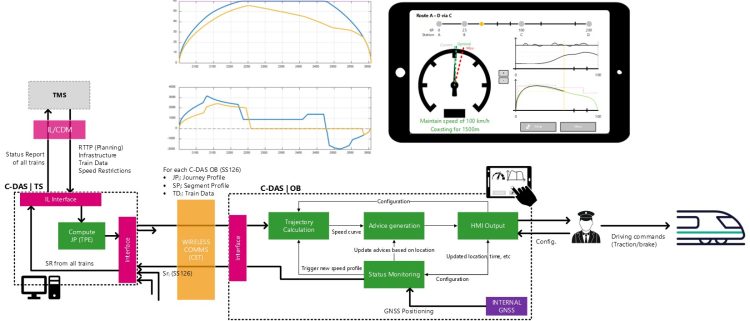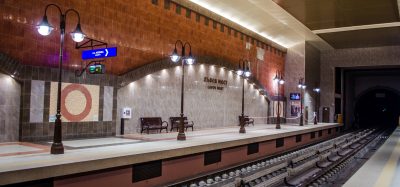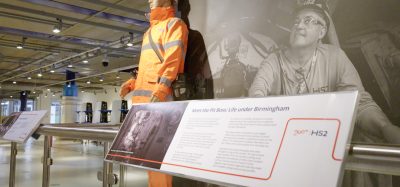Real-time Connected Driver Advisory Systems to enhance European railway operations
Posted: 30 September 2025 | Pablo Ciaurriz, Unai Diez de Ulzurrun | No comments yet
Pablo Ciáurriz and Unai Diez de Ulzurrun at Ceit – Basque Research and Technology Alliance (BRTA), share how advancing C-DAS technology, connecting it with traffic management systems and using standardised protocols can enhance interoperability and prepare rail networks for future automation.


Advancing C-DAS technology to strengthen efficiency in European railway operations
Railways across Europe and worldwide are undergoing rapid growth and transformation. Rising populations, continued urbanisation and ambitious sustainability targets are driving a shift from road and air transport to rail. Passenger numbers have steadily increased in many European countries, while freight operators are being asked to carry more goods by rail in order to reduce carbon emissions. This growing demand is putting pressure on already dense and complex railway networks.
In countries such as Germany, France, the Netherlands, and the United Kingdom, networks are operating close to capacity, making it increasingly challenging to balance punctuality, efficiency and environmental performance. However, in other regions such as Spain, complex terrain and steep gradients require careful driving, directly impacting energy consumption. In these contexts, the need for smarter and more adaptive driving support tools is particularly acute.
C-DAS addresses the rising demand for capacity and reliability today while simultaneously laying the groundwork for energy-efficient, digital, and automated railways of tomorrow.”
Driver Advisory Systems (DAS) have long been used to support train drivers with optimised speed profiles, improving energy efficiency and timetable adherence. Traditional DAS, however, has a key limitation: it relies on static schedules and cannot respond to real-time changes such as delays, congestion at junctions, or temporary operational restrictions.
Connected Driver Advisory Systems (C-DAS) were developed to address this limitation. By linking trains directly to traffic management systems, C-DAS enables continuous two-way communication and provides adaptive advice that reflects current operating conditions. This allows trains to move more smoothly through the network, avoiding unnecessary stops and saving both energy and time.
The growing relevance of C-DAS is also tied to the wider modernisation agenda in European rail, particularly the progressive roll-out of Automatic Train Operation (ATO). ATO promises major performance gains by automating certain driving tasks, improving headways, and boosting overall capacity. Yet, large-scale ATO deployment requires extensive investment in both onboard technology and infrastructure upgrades. C-DAS, by contrast, delivers many of the same benefits—better punctuality, reduced energy use and improved capacity utilisation—at significantly lower cost and with fewer modifications to existing rolling stock. As such, C-DAS is increasingly seen as a transitional solution: a way to deliver immediate operational benefits while preparing networks and rolling stock for future ATO integration.
In this context, C-DAS is not only a technological upgrade but also a strategic response to rail’s most pressing challenges. It addresses the rising demand for capacity and reliability today while simultaneously laying the groundwork for energy-efficient, digital, and automated railways of tomorrow.
Within the European railway sector, Ceit is one of the 25 founding members of Europe’s Rail Joint Undertaking (EU-Rail), and notably one of only two technology centres among them. Ceit is currently involved in six Flagship Projects (FPs), including FP1 – MOTIONAL.
The FP1-MOTIONAL project is driving the digitalisation of Europe’s railways to create a more seamless, resilient, and adaptable network—capable of adjusting capacity, integrating last-mile operations, and connecting every service into one truly interoperable system. Within this project framework, Ceit is developing C-DAS technology to enhance eco-driving performance, improve network capacity, and increase interoperability through standardised interfaces.
Core functions and benefits of C-DAS
Building on traditional DAS, C-DAS provides several key benefits that enhance the efficiency and effectiveness of railway operations. The principal strength of C-DAS lies in its ability to deliver actionable, real-time information that is tailored to both the train and the broader network. Drivers receive speed and timing advice that adjusts automatically as circumstances change. For example, if a train is running ahead of schedule and risks arriving at a junction too early, the system will recommend reducing speed slightly to avoid an enforced stop. Conversely, if there is an opportunity to maintain a planned path by accelerating within safe limits, the system will advise accordingly.


Illustration of how C-DAS connects with TMS to optimise train trajectories, generate driving advice, and support automation. Credit: CEIT-BRTA
One of the most widely documented benefits of C-DAS is improved energy efficiency. Rail transport already offers a lower carbon footprint compared to road or air travel, but the potential for additional savings is significant. By encouraging smoother acceleration, minimising unnecessary braking, and eliminating idle waiting times, C-DAS can reduce energy consumption by an estimated 5–15%. These savings not only reduce operational costs but also contribute to broader environmental objectives, particularly as the rail sector positions itself as a central pillar of sustainable mobility. Case studies from European operators have shown that even modest energy reductions at the individual train level can translate into substantial network-wide benefits when aggregated across fleets and routes.
Another key benefit is punctuality. Train delays often originate from small inefficiencies that ripple through the network. By keeping drivers constantly informed about the best way to align with the traffic plan, C-DAS helps avoid such cascading delays. For passengers, this translates into greater reliability and confidence in rail services. Drivers themselves also benefit, as C-DAS enhances situational awareness and reduces the cognitive burden of having to make constant manual adjustments without access to network-level information. Operational trials have reported reduced stress levels among drivers and improved adherence to timetables.
Financial and operational gains for operators are also significant. Reduced fuel or electricity consumption leads directly to cost savings, while less wear on braking systems and other equipment helps lower maintenance expenses. These combined benefits make C-DAS not just a technological upgrade, but a clear business case for more efficient railway operation.
Integration with railway infrastructure
The success of C-DAS depends heavily on its integration with the wider railway ecosystem, particularly Traffic Management Systems (TMS), which play a central role in coordinating the movement of trains across a network, ensuring that paths are allocated efficiently and conflicts are minimised. By connecting with TMS, C-DAS ensures that the advice drivers receive is fully consistent with the overall traffic plan.
However, integration does not come without challenges. Rail networks are often fragmented across multiple operators and infrastructure managers, each with their own systems, data formats, and operational practices. To maximise the benefits of C-DAS, standards must be established that ensure seamless operation across borders and between different stakeholders.
The use of an Integration Layer (IL) between the TMS and systems like C-DAS is essential for enabling interoperability across railway operations. It serves as the technical interface that translates and harmonises data exchanged between the two systems, ensuring that train schedules, paths, and operational updates generated by the TMS can be delivered in a consistent and timely manner to the C-DAS. Conversely, it allows the C-DAS to communicate train performance feedback and adherence information back to the TMS. By managing data formats, communication protocols, and synchronisation requirements, the integration layer ensures seamless interoperability, supporting real-time decision-making, improved traffic management, and optimal train operations across diverse railway networks and system suppliers.
To address these challenges, Ceit is developing a C-DAS system with integration and interoperability in mind, aiming to ensure compatibility with different TMS systems through the use of an Integration Layer that acts as a link and interpreter between systems with different data architectures. At the same time, the bidirectional communication between the two main components of the C-DAS—namely, Trackside (TS) and Onboard (OB)—is carried out using the standard communication protocol already applied in ATO (SS-126), since the type of information exchanged is similar. This use of standards will support the development of a more universal and interoperable C-DAS.
Future outlook and challenges
Looking ahead, the role of C-DAS is likely to grow as railways continue their digital transformation. Yet several challenges remain before the system can reach its full potential.
In the longer term, C-DAS may serve as a stepping stone toward more advanced digital systems.”
Deployment costs can be substantial, particularly for large fleets or networks that require significant upgrades to their traffic management systems and data management systems. Training drivers and control staff is equally important, as the effectiveness of C-DAS depends on it being used correctly and consistently.
Standardisation is another critical issue. Europe’s railway sector is highly fragmented, with multiple infrastructure managers, operators, and national systems coexisting on a relatively small continent. Without common standards, there is a risk of developing isolated solutions that cannot communicate effectively across borders. Additionally, there’s a need to digitalise detailed line data—such as track geometry, gradients, speed profiles, and signalling information—to provide the foundational inputs required for C-DAS to function effectively on their networks.
In the longer term, C-DAS may serve as a stepping stone toward more advanced digital systems. The data generated by connected advisory systems can be used to inform artificial intelligence and predictive analytics, enabling traffic management centres to anticipate disruptions before they occur. This opens the door to semi-autonomous or even fully autonomous train operations in the future. In this sense, C-DAS is not just a tool for today’s efficiency but also a foundation for tomorrow’s railway innovations.
Acknowledgements
The authors would like to acknowledge the final support to perform this work through the grants EU Project 101101973 – FP1-MOTIONAL. This project received funding from the Europe’s Rail Joint Undertaking under the Horizon Europe programme.
About the authors


Pablo Ciáurriz received M.Sc. and Ph.D. degrees in mechanical engineering from the University of Navarra (Spain) in 2010 and 2014 respectively. He obtained his PhD in the field of control theory and stability analysis for haptic devices. Since 2015, he is a researcher within the Railway Group in the Transport and Energy Division at CEIT-BRTA Research Centre in San Sebastián, Spain. He is currently actively involved in several research projects within Europe’s Rail initiative, namely MOTIONAL, RAIL4EARTH and TRANS4M-R. His main current research interests include railway systems modelling, energy consumption optimisation and energy-efficient driving strategies.


Unai Diez de Ulzurrun received his B.Sc. degree in Mechanical Engineering and M.Sc. degree in Industrial Engineering from the Mondragon University, Spain, in 2017 and 2020 respectively. He is currently pursuing his Ph.D. degree from TECNUN (School of Engineering of San Sebastián), Spain. He joined the CEIT-BRTA Research Centre in San Sebastián in 2023, and he is currently a Researcher assistant within the Railway group. He is now actively participating in EU-Rail Projects, including MOTIONAL and TRANS4M-R. His research interests include railway systems modelling, data interoperability, traffic simulation and disruptions management.
Stay Connected with Global Railway Review — Subscribe for Free!
Get exclusive access to the latest rail industry insights from Global Railway Review — all tailored to your interests.
✅ Expert-Led Webinars – Gain insights from global industry leaders
✅ Weekly News & Reports – Rail project updates, thought leadership, and exclusive interviews
✅ Partner Innovations – Discover cutting-edge rail technologies
✅ Print/Digital Magazine – Enjoy two in-depth issues per year, packed with expert content
Choose the updates that matter most to you. Sign up now to stay informed, inspired, and connected — all for free!
Thank you for being part of our community. Let’s keep shaping the future of rail together!
Related topics
Automatic Train Operation/Autonomous Train Control (ATO/ATC), Digitalisation, European Rail Traffic Management System (ERTMS), European Train Control System (ETCS), Interoperability & Liberalisation, Operational Performance, Signalling, Control & Communications, Standardisation & Technical Harmonisation, Sustainability/Decarbonisation, Technology & Software, Timetabling/Scheduling








